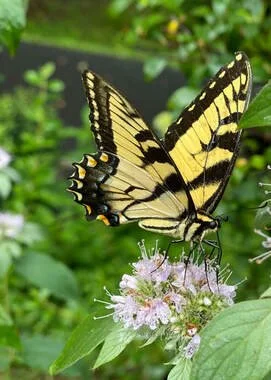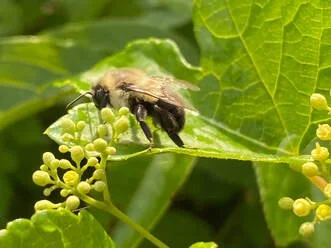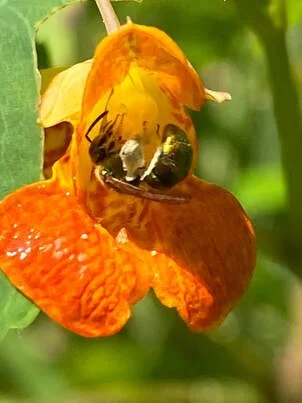It’s August—Time for a Safari!
Eastern Tiger Swallowtail Butterfly by Martha Baskin
by Phyllis Stiles, Founder & Director Emerita of Bee City USA
Binoculars? Check.
Camera? Check.
Sunhat? Check.
Sunscreen? Check.
Water? Check.
Hiking boots? Check.
We were ready for our safari.
It was early August and summer was heating up. Our expedition would parallel a river, lush with radiant flora and active fauna. Being well equipped was crucial to enjoying and capturing the experience. We hoped to see some tigers, herds of furry feeders, and maybe even a zebra.
Would it be dangerous? Not really. How close could we get to the animals? If we approached slowly and quietly, within inches. The excitement was palpable as we closed the truck doors to enter the jungle rich in a diversity of native flowers—Wingstem, Monarda, Goldenrod, Joe Pye Weed, Great Blue Lobelia, Southern Sneezeweed, False Sunflower, Common Boneset, Fleabane, Black-eyed Susan, Clethra, Jewelweed, Ironweed…. About that same time, we saw luscious blackberries ready for the picking. We were entering the Wilma Dykeman Greenway along Asheville’s French Broad River next to New Belgium Brewing. With any luck we would see Tiger Swallowtail Butterflies, a Zebra Swallowtail Butterfly, and herds of hungry bees.
Within minutes, my companions, Florrie Funk and Martha Baskin, were snapping their cameras. There it was, a Tiger Swallowtail nectaring, with proboscis fully extended, on a Hoary Mountain Mint (Pycnanthemum incanum) flower. Was it an Eastern (Papilio glaucus) or an Appalachian (Papilio appalachiensis)? The Eastern Tiger tends to be a slightly smaller, and has thicker vertical black stripes, more blue on its hindwing (lower wing), and a spotted yellow band on its forewing’s (upper wing’s) underside, compared with a solid broad band on the Appalachian Tiger. So ours must be an Eastern. Was it male or female? It’s harder to tell on the ventral (under) side of the wings, but the bluish area on the ventral hindwing has one row of orange spots—she must be a lady!
American Bumble Bee on New York Ironweed by Phyllis Stiles
But it was the buzzing herds of bumble bees that would dominate our safari. There are only 48 species of bumble bees native to the United States. We identified our specimens by the color of their abdomens’ individual segments and the black and yellow patterns on their thoraxes.
Seduced by the New York Ironweed’s (Vernonia noveboracensis’) dense flower clusters, a majestic American Bumble Bee (Bombus pennsylvanicus) was methodically working her way around the individual florets, following the nectar guides to the carbohydrate hidden deep inside. The band of yellow located only at the top of this bee’s thorax and the three yellow bands at the top of the abdomen convinced us this bee was the American bumble.
Flowers learned long ago to bury their treasure, forcing visitors to pick up pollen from their anthers along the way. By the looks of this lady’s pollen baskets, the technique is working! Male bees don’t have pollen carrying hairs since they don’t care for the young.
Common Eastern Bumble Bee by Florrie Funk
The common Eastern Bumble Bees (Bombus impatiens) were feasting nearby on the invasive exotic Porcelain Berry Vine. By the look of our model’s empty pollen baskets on her back legs, either she was all about the Porcelain Berry flowers’ sweet nectar, not its pollen, or “she” was a “he” with no need or means to gather pollen. Sadly, the pollinators are helping invasive species like Porcelain Berry and Japanese Knotweed thrive, and often outcompete our native plants. While bumble bees, like most generalist bees, can gather pollen and nectar from a wide variety of flowers, the specialist bees that comprise more than 25% of the world’s 20,000 bee species, don’t have that luxury. They have co-evolved with a limited number of native plant species to feed their young the pollen exclusively from that select group of plants.
The Partridge Peas (Chamaecrista fasciculata) were in full bloom, and the bumble bees knew it! We watched in awe as the bees latched their front legs to the annual flowers’ petals and inserted their proboscis into its center, just like an elephant guzzling water with its long trunk. If you turn up your volume and listen closely, you can hear the bees “buzz pollinating” the partridge pea, causing it to release its pollen.
Bumble bee buzz pollinating Partridge Pea by Phyllis Stiles
Herds of bumble bees covered the Sweet Pepperbush (Clethra alnifolia) in full bloom!
Bumble bees on Clethra by Florrie Funk
Furrow Sweat Bee by Florrie Funk
The other bee herd we saw on our safari was the ever-colorful sweat bees—the ones that sometimes land on our arms to gather our salty sweat. With legs covered in yellow pollen from a New England Aster (Aster novae-angliae) and sporting that tell-tale black and white striped abdomen, this Furrow sweat bee (in the Halictus genus) seemed to be so cool, she had to wear shades. Try as we might, we were unable to really determine this gorgeous Furrow bee’s species.
Florrie got really excited when she filmed a Bicolored Striped Sweat Bee (Agapostemon viriscens) furiously collecting pollen from a False Sunflower (Heliopsis helianthoides) with her front legs and transferring it to her back legs to provision her nest for her young. These bees are known for banding together in communities of individual ground nests and sharing their guard bees.
Bicolored Agapostemon Sweat Bee by Florrie Funk
Green metallic sweat bee by Florrie Funk
Sand Wasp on Common Boneset by Phyllis Stiles
Green Metallic Sweat Bees were slurping nectar from the orange Jewelweed (Impatiens capensis) all along the greenway. Although hummingbirds frequent Jewelweed too, we weren’t lucky enough to see them on this safari. Jewelweed is especially at home near rivers and streams since it can tolerate flooding. When its seed pods ripen, they explode, giving the plant its nickname, Touch-Me-Not.
We were really excited to see the bees’ ancestors, the wasps, nectaring on Common Boneset (Eupatorium perfoliatum) and Goldenrod. They tend to hover around 18 inches off the ground when not burrowed in their solitary sandy nests and don’t sting people like social wasps do. Sand wasps feed house flies, deer flies, mosquitoes and brown marmorated stink bugs to their young! A single, developing sand wasp larva may eat two dozen flies.
Sadly, we never saw the elusive Zebra Swallowtail (Protographium marcellus). There must not be any Pawpaw trees, its caterpillar host plant, nearby. But that just means we’ll have to plan another safari soon!






